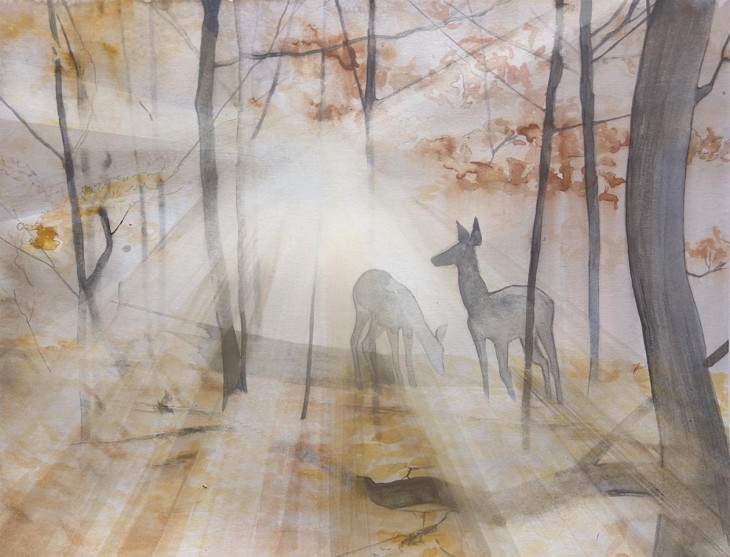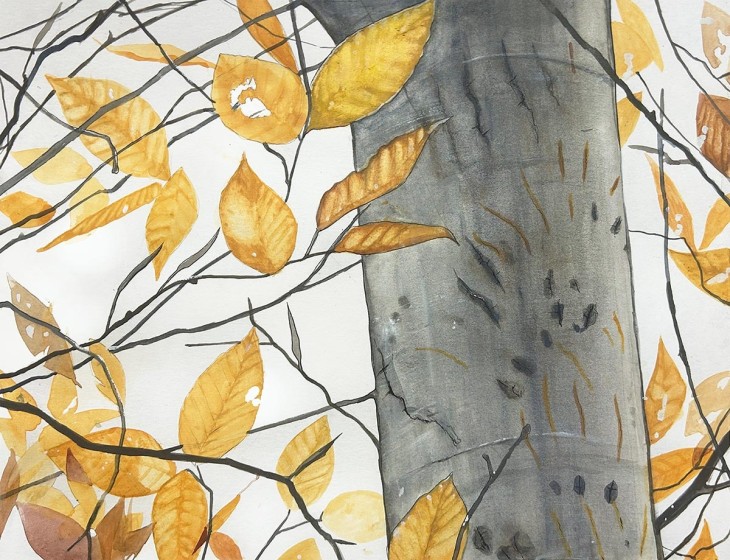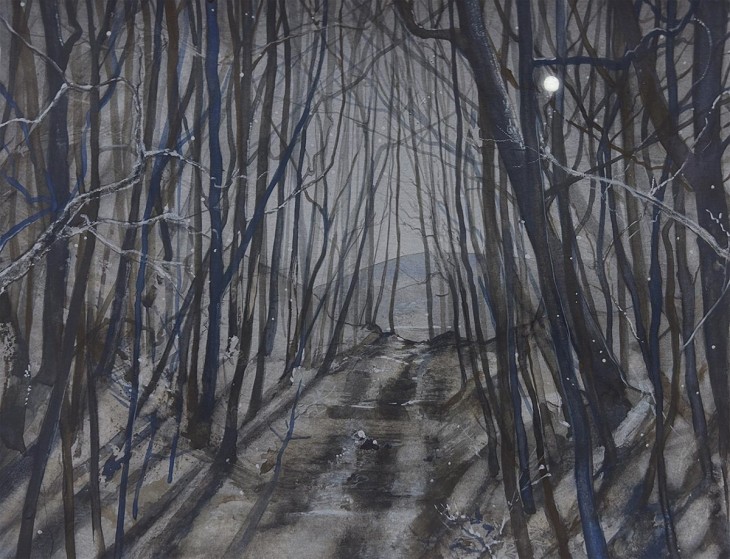Dad and I drag the white-tailed doe to the abandoned logging road as the moon crests the mountain. By the light of our headlamps, we use our knives to carve and empty the deer, our breath freezing, rising in puffs above the red canyon of her chest. I thresh her heart from the rest of the organs and stuff the slick stone of muscle into a plastic bag for tomorrow’s dinner. When I pull on my pack, I feel the knot of it between my shoulder blades.
As the doe drains, Dad and I turn off our lamps and watch the ridge reflect the moonlight between the trees. With every passing minute, the woods grow brighter on the plateau. We’re on a cusp – of the drag, of the chore that precedes our eating – and speak softly, reverently, about the deer. Shooting light gone, our rifles empty. Hands warm and sticky from this bodily work.
Just an hour before, we’d finished our sit and begun the long descent off the Allegheny Front toward the valley, a hike that always seems longer without the gift of an animal that will feed us in the coming year. The beech I sat under that afternoon had been marked by the claws of a black bear. It is the tallest tree on this plateau and the thin lines, just above my head, were pumpkin-orange – fresh from the fall. Generations of bear have sketched their signatures in the smooth, gray bark, and the older scars, higher on the trunk, have healed and expanded with time.
Later, as we walked – Dad behind me, a light snow falling, the day pitching itself toward the west – I thought about where the bears might have wedged themselves for the white months ahead. The core-rotted center of a pine? Between the exposed rock on the ridge? Down by the creek where water would play a winter-long lullaby?
I was still thinking of bears when I saw the doe with another beside her through a thicket of wrist-thick birch 15 yards away. Both deer stood motionless, likely believing themselves hidden in the pink air of evening. The back doe dropped with the shot, and the other bounded into the rhododendron, leaving the last scalloped tracks of the day in the snow.
When I approached where the doe had fallen below the rise, I half believed she had disappeared, her departure as abrupt as her instantaneous appearance moments before. Yet there below the lip of the ridge she lay, still and warm, head thrown back like a horse in some oil painting. Mouth clean and open. Blood not yet dripped from the fur.
The moon’s belly sags heavy in the sky as the doe finishes draining, and Dad and I each grab a back leg to begin the drag off the mountain. The snow shines, and we can see across the hollow to the shadows of trees. Within 10 minutes, we’ve shed our coats, and our chests and backs are as damp as the ground around a spring. The deer’s legs are tacky with blood, and our hands and forearms begin to ache. The cold and effort bend our fingers into hooks that we gently unfurl at every rest.
I recently finished a college basketball career, and when Dad says he works for the university, people assume that he’s on the grounds crew (not in the English department) because of his muscled arms. Still, this is exhausting work. During the next half hour, our breaks become more frequent, the distance we drag the doe shortening with each attempt. Doe or buck, we’ve never seen a deer this large, and it hadn’t crossed our minds to bring game bags so we could quarter the meat and pack it out on our backs.
The doe’s body shows the mountain years she endured. The tape measure we wrapped around her chest helped us estimate her weight: just shy of 200 pounds. Every ounce knitted by hickory, oak, and beech. Her teeth are worn flat. Chipped grooves in her hooves suggest many sprints across talus. Her fur thick to offset the deep cold that penetrates these ridges, 2,000 feet above any corn or bean field. Strong legs vaulted her from the coyotes and bears that kept noses high for her scent.
We take another break and listen to the first faint whirs of water from the stream. False promise that we are nearing the valley floor.
The croaks of ravens that vibrated the woods all afternoon are now absent. These birds follow the ridges running north to south, searching for gifts hunters leave behind in the form of kidneys, livers, and stomachs. If the coyotes aren’t quick tonight, the ravens will find their breakfast early. We piled enough there to pull them down from the sky.
Owl hoots replace the ravens’ voices, their low calls bouncing from one ridge to the other. I imagine one turning at the faint scratch of a deer mouse’s claws on snow. Air is heavier this late in the year. It seems to carry sound forever.
The world has shifted to shades of gray: my skin, the doe’s eye, Dad’s coat. Even the blood streaking behind the deer has lost its red this far into night. My usual, constant scanning of the woods has been reduced to focus on the trail in front of me. Despite the lack of color, the mountain’s contours are familiar. A sensation not unlike seeing a skull. Something barren. Scoured. But still, I can stitch together a place, a face, I recognize. We won’t get lost going downhill.
As we begin our next bout of dragging, I remember this is the labor I dream of all year. The most honest work I do. Dragging meat home to eat is one of the oldest acts, which I believe makes it sacred, fundamental.
I eat deer year-round. Every week, most days. Ounces of me crafted by their bodies. Steaks, sausage, roasts. My favorite is jerky. Ruby lengths of meat peppered and nailed to boards above wood smoke. On long days hiking up brook trout streams, I will chew and suck the flesh, evoking memories of the cold and this deer.
An hour since our last drink of water, and still half a mountain to descend, my fatigue and the morning’s early rising catch me in the crease. In the stupor, my mind conjures all the other deer this mountain has seen carried off its slopes, a lineage of hunters and their kills. The grandparents, the grandparents’ grandparents, the Delaware and Iroquois people, the people before them. And on their backs: the bears, bobcats, turkeys, fisher, rabbits, and squirrels. And elk, wolves, and cougars, before human hunger and greed devoured them. Whatever ghosts we’re walking with on this path, I’m grateful for them.
Dad and I spend most months out of the year fishing thin creeks to the mountain’s crown, discovering deer cover, and finding talus slopes filled with lowbush blueberries. I admire the endurance of my father, 30 years older than me to the day, the reward he finds after wading over shifting stones for six hours or more. In our walking, we speak in the way fathers and sons have learned to speak to each other in the woods. Which is also an old thing. A sacred thing. Fundamental.
Our conversation typically begins with a focus on animals or fish, then tendrils out into the world beyond the mountain’s shadow: school, work, writing, family. But tonight, it is cyclical, as if our words are pulled by the gravity of the deer, unable to escape the body of our weariness and joy. Neither of us becomes bored with each other’s retelling of the shot, the discovery of her size, how grueling this drag has become.
Dad asks to stop for a rest, and we drop the deer. We each question if we’ll reach the road this side of midnight. Should we slice the heart and eat something now?
It’s cold. The temperature below freezing all day, and with the sky empty of clouds, whatever warmth the sun left has disappeared into the stars. Dragging makes for sweating bodies, but the shells of our cheeks are numb and our noses are red.
As we stand, strands of muscle shaking up our legs, hands on our sides, Dad slowly moves to the trail side surveying the rails of black birch. He finds a thin sapling and motions me over. We hack the bark with our gutting knives until the wood frays and we twist it apart. I push the pole between the hide of the doe’s back legs, and we yoke ourselves to the birch.
This deep in the hollow, where it bends like a heron’s neck, we’re shielded from the moon, and the night goes black. But we don’t pause to turn on our headlamps. Electric light would ruin our last half-mile.
The doe’s nose knocks against the ground as we walk. A new way of keeping time. The largest bone on the top of our spines rubs raw from the bark as our shoulders flex against the wood. Dad and I are hidden from each other by her heft. Our stepping has nearly tripled with the deer pole, but still, we rest every 5 minutes. Where the hollow widens near the road, we rest again and savor the last moments on the mountain with this deer. Ice bells dangle over the stream as we cross.
I try to imagine another hunter walking the logging road and seeing us coming through the dark. Two men in wool clothes, carrying a deer between them on a sapling, our breathing heavy and loud. Would they think, for the briefest of moments, that we were ghosts? That somehow they’d unzipped time and fallen through? That’s how I feel, moving through the night. Like I’ve unfastened myself from everything that isn’t the mountain, the deer, and the drag.
We load the doe into the bed of the pickup and slump into our seats. Sitting for a minute, waiting for our legs to recognize what it means to be still. After hours of only moonlight, we wince in the headlights of passing cars. Steam streams from our bodies and fogs the windows. The moon is somewhere behind us, caught in the thin sliver of sky above the hollow. In the silence on the ride home, I realize I’m still caught, too.




